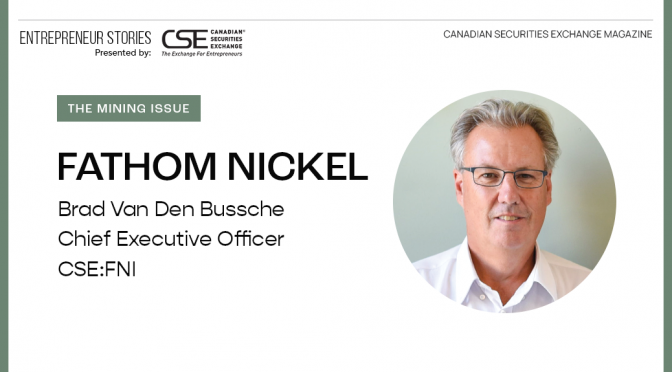Fathom Nickel (CSE:FNI) is, first and foremost, a high-grade story. There is a reason that the company managed to raise $11.5 million last year before going public on the Canadian Securities Exchange in May 2021. That reason is the historic Rottenstone nickel deposit.
Nestled in northern Saskatchewan, Fathom’s Albert Lake project is home to the formerly producing Rottenstone mine, which yielded eye-popping nickel grades of over 3% during the 1960s.
Fathom acquired the property in 2015 during the bottom of the nickel cycle and has since expanded its holdings in the area. Today, Albert Lake consists of over 90,100 hectares, of which more than 80,000 remain virtually unexplored. The company plans to apply modern exploration methods on the property in a bid to prove that those historic grades were no fluke.
Chief Executive Officer Brad Van Den Bussche and Vice President Exploration Ian Fraser founded the company in 2015 with the goal of acquiring highly prospective battery metals projects in favourable jurisdictions. They spent time in the US early on, going from conference to conference in the battery technology space to get a feel for which metals were going to be needed as technology advanced. It was nickel that won the day.
“Ian and I both had some experience with Albert Lake and Rottenstone from years ago, so we knew the asset had had very high-grade nickel, copper, PGE’s (platinum group elements) and cobalt,” Van Den Bussche explains. “And we were able to get it at the bottom of the nickel market for a very good price. Basically, we picked up the core property for some shares and a royalty that we recently bought back.”
According to Van Den Bussche, it was indeed the grades that first attracted them to the project.
“It was a combination of the grades and the mineralogy – the type of minerals that were in the mix. There’s a built-in hedge having nickel, copper, platinum/palladium and cobalt in there,” the CEO says. “It’s one of the highest grade nickel deposits mined in Canada.”
Globally, there is a handful of very high-grade nickel deposits, such as Norilsk in Russia. Closer to home, the Raglan mine in Quebec and Voisey’s Bay in Newfoundland both stand out. The Rottenstone grade was essentially as good – or even higher – than some of the biggest economic deposits currently in operation. Fathom’s team believes that Albert Lake’s geological setting supports the thesis that the Rottenstone is one of several variable size, high-grade nickel deposits similar to the multiple deposits that make up the Raglan nickel camp.
Not all nickel deposits are created equally, of course. There are essentially three types of nickel sources: limonite ore, saprolite ore and nickel sulphide ore. Currently, nickel sulphide is the preferred source to develop high purity Class 1 nickel which goes into creating nickel sulphate required for battery production. The pathway to creating Class 1 nickel from limonite and saprolite ores is more costly and typically creates a much larger environmental footprint.
It should come as no surprise that Albert Lake is a sulphide deposit. From the outset, sulphide opportunities were the focus for Fathom’s team.
“From Day One, we were focused on sulphide deposits,” Van Den Bussche says. “Our mandate is to look for electric vehicle battery minerals that are high in grade, particularly nickel. Nickel sulphide deposits are basically the main pathway to Class 1 nickel, which is necessary in the production of stainless steel and the EV/battery components.”
The mineralization of the historic Rottenstone deposit is unique and contains several notable associated metals. Initial sample metallurgy indicates metal recoveries of greater than 90% nickel, copper and cobalt are possible – all essential ingredients for the green economy. Furthermore, initial studies indicate recovery in excess of 80% can be expected from palladium and platinum.
Things look encouraging at the historic Rottenstone deposit, but with 80,000 hectares left to explore, the challenge for Fathom is to find out whether those grades extend throughout the property. The original deposit itself was small, which doesn’t faze Van Den Bussche, but he knows that the team must prove there is more there than just Rottenstone.
“We need to focus on understanding the system,” Van Den Bussche says. “Those kinds of high grades have to come from a very large system. There’s just no way in the geological model concept that you can have those kinds of grades without a large melting pot. The Rottenstone mine has to be one deposit within a much larger system.”
To that end, Fathom is planning an airborne electro magnetic survey and follow-up ground geophysics to zero in on prospective drill targets this year. A key part of its exploration activity is utilizing a portable Vanta XRF Analyzer (pXRF) to provide real-time litho-geochemical, multi-element data on core from current drill holes, and on historical drill core left by previous operators.
The pXRF results confirm the presence of nickel and copper in present and historic drill cores, and assay results will also test for the presence of platinum group elements, a significant component of the historic Rottenstone deposit that is not detectable via the pXRF.
Saskatchewan may not seem like the first place a company would visit to explore for nickel, but the province is quickly emerging as a leading global mineral jurisdiction. The Fraser Institute’s annual investment attractiveness survey ranked Saskatchewan in third place in 2020, with a particular spotlight on the province’s mineral potential. The prolific Trans-Hudson Corridor runs directly through the province then veers east to cover northern Manitoba, northern Quebec, northern Labrador and across to Greenland.
What has held Saskatchewan back from developing its own world-class base metal deposits has historically been, in part, the political situation. But that has changed completely in the last 20-plus years, according to Van Den Bussche.
“During much of the 1970s and 1980s, a Saskatchewan Crown Corporation (SMDC) had the rights to become up to a 50% partner in exploration projects in the province. While a lot of exploration and development was occurring next door in Manitoba, many exploration companies chose not to take on a government partner and explore in Saskatchewan during this period,” Van Den Bussche explains.
“But that has completely changed and now Saskatchewan is a great jurisdiction to work in. There is a lot of opportunity, and it’s getting a lot of interest from many companies, including the majors. Rio Tinto is a major explorer in the province, and BHP is starting to look as well – they already know Saskatchewan because they’re a big player in the potash industry. Saskatchewan is in the right place in the system, and it’s got the potential to have continuations of some of the Manitoba base metal opportunities, including nickel.”
Fathom is operating during a wild time in the nickel industry. The silvery-gray metal is an essential component in electric vehicle batteries, and manufacturers are scrambling to secure safe supplies. As the green energy economy ramps up, so too does nickel demand – so much so that in early 2022, trading was suspended on the London Metals Exchange after nickel prices breached the $100,000 per tonne mark.
For Van Den Bussche, the dynamics of the current nickel market point to the necessity of developing a safe, stable supply of the metal within North America.
“There is definite urgency to try to lock up some supply of nickel from mines that are currently producing, but also to feed the supply chain two, three, four or five years out. Good projects in good jurisdictions that have a pathway to growing a resource and getting into production are essential. I think there’s going to be a huge move to gain control of the raw materials needed for these strategic businesses.”
This story was featured in the Canadian Securities Exchange magazine.
Learn more about Fathom Nickel at https://fathomnickel.com/.


